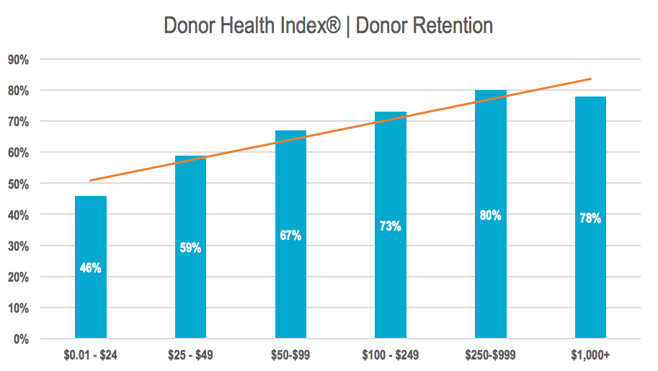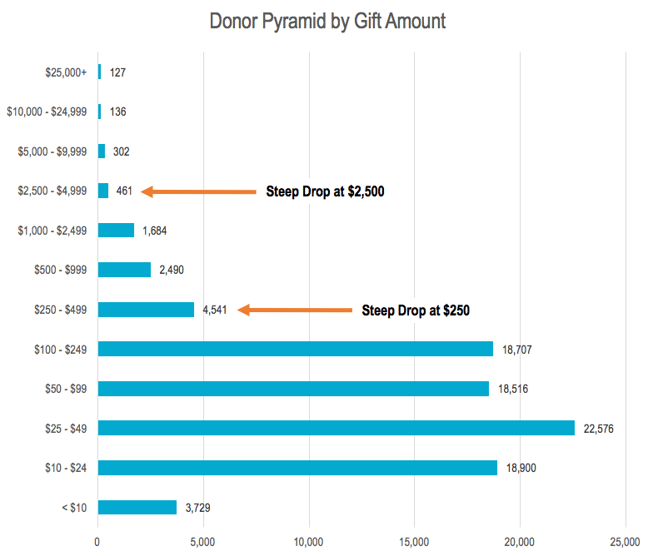
Who Are Your Mid-Level Donors and How Should You Treat Them?
Mid-level donors are an enigma to fundraisers. They give too much to be included in a traditional direct-response fundraising program, yet they give too little to warrant an assigned major gift officer. Until recently, mid-level donors have been lumped into one of these two groups — not a good fit!
Fundraisers realize there needs to be a strategy specifically designed for mid-level donors. The fundraising industry's ongoing conversation about mid-level donor fundraising programs centers around one question: Who are mid-level donors, and how should we be treating them?
How Do You Define Mid-Level Donors?
Mid-level donors are typically defined by their annual cumulative giving, which is the total amount they give to the organization within the fiscal year. The specific giving level to qualify as a mid-level donor varies by the size of the nonprofit and its current donor base.
For most nonprofits, mid-level donors are donors who have been active in the last 24 months with a cumulative annual giving level of $1,000–$9,999. Here are three reasons we came to this definition:
- Mid-level is the step before a major gift, which is typically defined as cumulative annual giving of $10,000+.
Based on our donor research and data modeling of the tipping points to a major gift, we know it is most common that the donor’s last or largest gift before moving to the major gift level is between $3,000–$5,000. The data shows that it is uncommon for a donor to skip this mid-level and jump from a $250 gift to a $10,000+ gift. - A successful mid-level donor program requires a financial investment.
Strong mid-level programs typically require an investment of $35–$55 per mid-level donor. This cost has a positive return on investment at the $1,000+ giving level, but struggles to break even with donors who give $100. - The primary objective for implementing a mid-level program is to create a path to transformational giving.
When a donor is involved at the $1,000+ giving level, it indicates that she has an active interest in your mission and goals. A mid-level donor program deepens the donor relationship by encouraging a two-way communication stream within this segment of your donor file.
Why You Need a Mid-Level Program
Mid-level programs should be a critical part of your comprehensive fundraising strategy. Mid-level donors tend to fall into an unintentional black hole. Since they are giving more, development directors (with only good intentions) pull them from the everyday direct-response appeals. Major gift officers tend to ignore them, since they don’t quite meet the historical giving tipping points to move them to a portfolio. A worst-case scenario is that they get moved to a major gift portfolio only to languish and eventually drop out of direct-response programming all together.
Donor Retention
As a result of being lumped into these ill-fitting groups, many organizations struggle with donor retention at this all-important giving level. This presents an opportunity to implement a mid-level program and retain these valuable donors.
This is what typical donor retention by giving level looks like:

As you can see, the donor retention rate steadily increases as the gift amount increases. However, the donor retention decreases once donors reach the $1,000 annual giving level. A program specifically tailored to mid-level donors will increase donor retention.
Donor Pipeline Clogs
We have studied data sets from hundreds of nonprofits. Unfortunately, almost all these organizations have a clog in their donor pipeline. We define a clog as the points in the pipeline where we see a significant drop-off in donors. These clogs are almost always at the $250 and $2,500 giving thresholds. Since most donors give $3,000–$5,000 before their first major gift, the $2,500 threshold is particularly dangerous. It blocks your active donors who believe in your mission from moving through the donor pipeline and increasing their giving to a transformational gift.
This is what we typically see in an organization’s donor file without a mid-level program:

A well-executed mid-level program will break these clogs and get donors moving in your pipeline again, leading to greater success for the nonprofit you’re serving. If you have further insights about mid-level donors, we’d love to hear them. Feel free to share your experiences with mid-level donors below!
